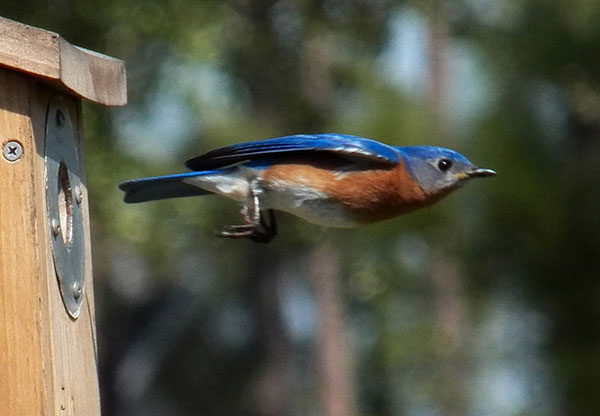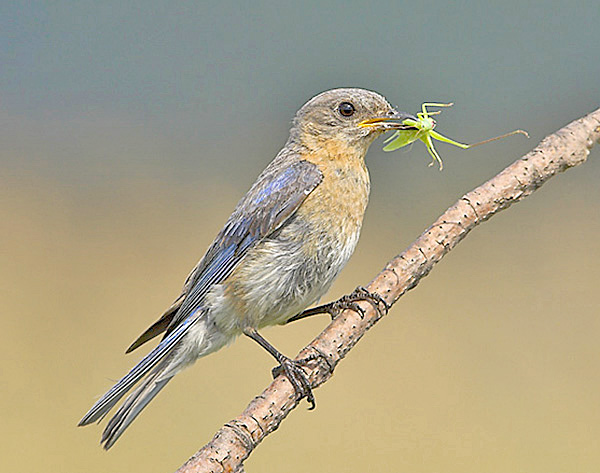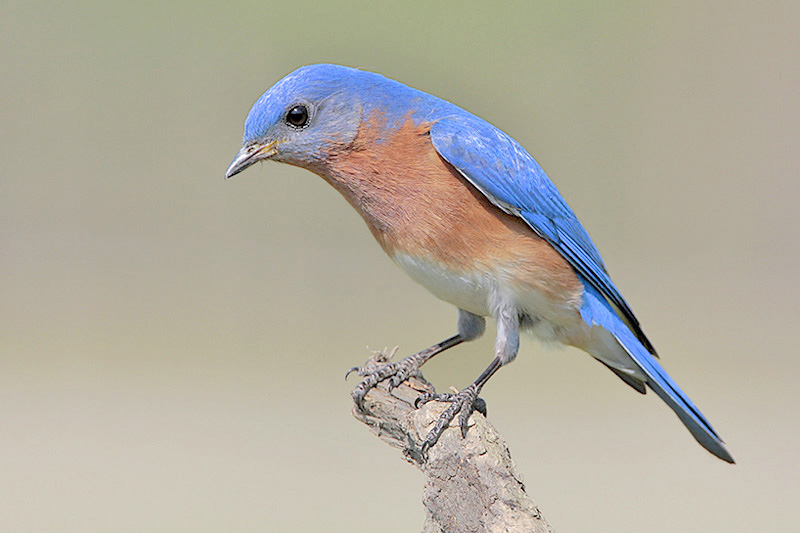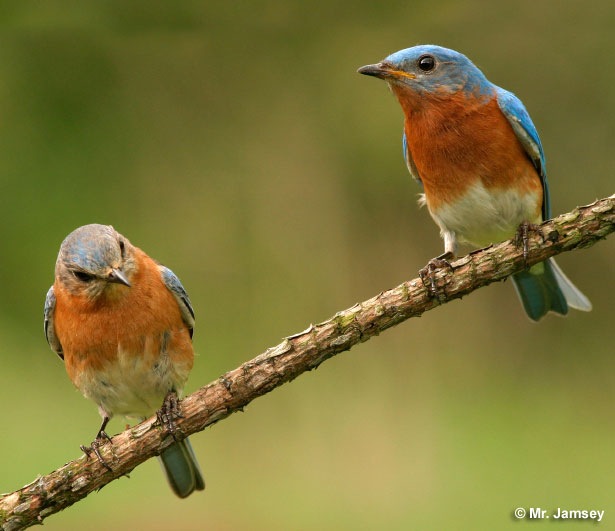
Missouri state bird is the Eastern Bluebird, a small songbird with royal blue coloring on its head, back, and wings, brownish red breast, and white abdomen.
Missouri is a state in the Midwestern United States that places somewhere in the middle of the list in terms of area and population when compared to the other 50 states.
It is the 21st largest state by area, being 69,715 square miles large, and 19th most populated, with just a bit over 6 million inhabitants. Missouri often experiences extreme weather, and generally has cool, sometimes cold winters and hot, humid, and wet summers.
On this page
History
Eastern Bluebird (Sialia Sialis) was adopted as the state bird of Missouri in 1927, by the Missouri Legislature.
It was chosen because it symbolizes joy and happiness and because it was a common bird in Missouri.
People liked its song, beautiful plumage, and non-aggressive nature. Eastern Bluebirds are also useful, helping to control insect populations.

Female. Photograph © Glenn Bartley.
Facts about The Missouri State Bird
- Eastern Bluebirds have exceptional eyesight and can see tiny bugs from up to 60 feet away.
- Male bluebirds sing with their beaks closed and may sing up to 1000 different songs an hour to attract a mate.
- It is likely that 70% of all bluebirds die before they reach their first birthday. The oldest known wild Eastern Bluebird, however, lasted for 10 years and 6 months.
- Bluebirds are considered to be indicators of the arrival of spring, therefore symbolizing happiness, love, hope, and renewal.
- The Eastern Bluebirds choose small cavities to nest in. The male chooses the nest site and then puts on a display to attract a female.
Identification
Eastern Bluebirds are small birds that have short, slender, black bills and legs, and black eyes.
They measure 6.3-8.3 inches in length with a wingspan of 9.8-12.6 inches, and they weigh 0.95-1.2 oz.
This avian is often recognized thanks to the male Eastern Bluebird’s bright-blue upper parts, cinnamon chest, and white belly. The female is duller in color and doesn’t have as much blue.
Their head is gray and the blue they have on their wings and tail is duller and appears more grayish. The young are light gray and have a light orangish-brown chest and blue wingtips. The colors become more prominent as they age.

Photograph © Greg Lavaty.
You can find Eastern Bluebirds almost everywhere east of the Rocky Mountains, from southern Canada to Mexico. Eastern Bluebirds prefer open areas with little to no ground cover and scattered trees for perching, nesting, and feeding.
You can see these birds in pastures, fields, suburban parks, and backyards, but also in mature open woodlands and forest openings. They like to perch on utility wires and sit on fences.
Eastern Bluebirds like to build their nest in trees that have holes in them or in other cavities that provide protection, including nest boxes.
The nest itself is small and made of twigs, weeds, and dry grass, lined with finer plant material and sometimes with animal hair and feathers. The female Eastern Bluebird lays 3-7 light blue, sometimes white eggs that are a bit less than an inch in length and 0.6-0.8 inches in width.
Call of Missouri State Bird
Eastern Bluebirds communicate primarily through vocalization, and they have different songs for mating, marking territory, and warding off predators.
The song of Eastern Bluebird is a quite low-pitched warbling, lasting about 2 seconds and consisting of 1-3 short notes. The unpaired males sing from a high perch or in flight, trying to attract a female. Females sing when they see predators in their territory.
The Eastern Bluebird’s calls are low-pitched warbles with phrases such as chir, wi, chur lee, truly, and purity, lasting around a second.
When adult birds get too close to each other, they make a harsh screeching sound to let the other know. A loud chit-chit-chit can be heard when predators are nearby.
They call for many different reasons, from signaling nestlings that food is coming to letting others know that predators are nearby.
Behavior
Eastern Bluebirds are mostly carnivores. Their diet in the summer consists of insects and larvae, spiders, grasshoppers, worms, caterpillars, and snails, but during fall and winter, they also eat berries such as black cherry, blueberries, blackberries, currants, wild holly, juniper berries, elderberries, hawthorns, etc.
When feeding, they observe their prey from a low perch and then swoop down to catch it, sometimes catching insects mid-air. When feeding on berries, they either perch or make short hovering flights to get their food.

Eastern Bluebirds are very social, sometimes gathering into flocks numbering over a hundred birds, but they’re also territorial when it comes to defending their nests and feeding territory around them.
They mate in the spring and summer, forming monogamous pairs that remain together for more than one season, although that is not always the case. During courtship, the male may sing and flutter his wings in front of the female with his wings and tail partly spread.
The pairs can be seen preening each other’s feathers, and the male may feed the female. The nest is primarily built by the female while the male gathers the nest material. Eastern Bluebirds often use existing birdhouses and even old woodpecker holes.
The female is in charge of incubating the eggs, whereas the male surveys and protects the surrounding territory. The fledglings, upon hatching, leave the nest 15-20 days after hatching but until then, both parents bring them food, mostly insects.
Eastern Bluebirds are partly migratory, leaving their homes in the north when food sources dwindle or when other conditions are not suitable. In the southern part of their range, they will stay throughout the year.
Which Other Birds Can You See In Missouri?
Missouri is a state of wonders – there are more than 400 bird species you can see throughout the year. While some of them are rarer than others, there are still plenty of songbirds, hawks, owls, woodpeckers, and even ducks that you can see!
Here are some of the most common bird species!
- Northern Cardinals
- Blue Jays
- Mourning Doves
- Red-bellied Woodpeckers
- Downy Woodpeckers
- Tufted Titmice
- American Robins
- American Crows
- American Goldfinchs
See next: Most Common Birds of Missouri
Frequently Asked Questions About Missouri State Bird
What is the state bird of Missouri?
The state bird of Missouri is the Eastern Bluebird.
Why is the Eastern Bluebird the state bird of Missouri?
The Eastern Bluebird is the state bird of Missouri because it is native to the region and represents happiness and hope. Its vibrant blue plumage and delightful song make it a beloved symbol of the state’s natural beauty.
When did Missouri choose its state bird?
Missouri chose the Eastern Bluebird as its state bird in 1927.
What other states have the Eastern Bluebird as their state bird?
In addition to Missouri, two other states have the Eastern Bluebird as their state bird: New York and Idaho.
What is the state animal of Missouri?
Missouri state animal is the Missouri mule, which was chosen as the state animal in 1995.
